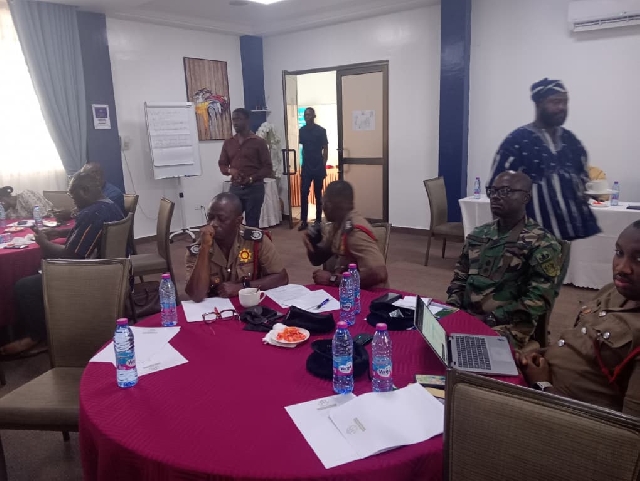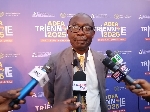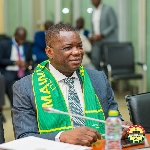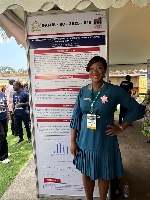NADMO in partnership with UNDRR strengthens Ghana’s policy frameworks for Disaster Risk Reduction and Resilience building
 Participants atthe event in Accra
Participants atthe event in Accra
The National Disaster Management Organisation (NADMO), in collaboration with the United Nations Office for Disaster Risk Reduction (UNDRR), is taking significant steps to strengthen Ghana’s policy frameworks and enhance national and local capacities for risk management and resilience building.
At a three -day capacity building workshop to draft a National Platform for Disaster Risk Reduction and Climate Change Risk Management (CCRM) in Accra on the topic: ‘Advancing Comprehensive Risk Management and Local -Level Resilience in Ghana’ brought together stakeholders from academia, media Environmental Protection Authority, National Development Planning Commission, National Peace Council, Ghana Health Service, Ghana Highways Authority, Ghana Metrological Authority, Ghana Hydrological Authority, Ghana National Fire Service, Ghana Armed Forces, Ghana Police Service, GIZ, UNDP among others to fine-tune the draft platform.
In a welcome address, Madam Charlotte Norman, Director for Climate Change Adaptation and Disaster Risk Reduction at NADMO, said the organisation outlined the main objectives of this year’s observance.
These include raising awareness on financing resilience, advocating for increased national and local budget allocations for DRR and climate adaptation, and strengthening partnerships among government, the private sector, development partners, academia, and civil society.
“NADMO’s achievements in advancing early warning systems, community preparedness, and climate adaptation demonstrate Ghana’s progress toward building a resilient nation,” Ms. Norman stated.
“We respectfully request support for this important symposium, which will bring together national government representatives, the business community, international donors, development partners, civil society, and academia.
She said, this strategic partnership seeks to align Ghana’s disaster risk reduction (DRR) agenda with global best practices while ensuring local communities are at the centre of planning, decision-making, and implementation.
According to her, NADMO’s initiative focuses on several key areas designed to build sustainable resilience across all levels of governance and society:
Policy Development: Strengthening and implementing national and local policies that prioritize disaster risk management and climate resilience. Community Engagement: Actively involving local communities in risk assessment, planning, and decision-making to ensure interventions are relevant and sustainable. Capacity Building: Providing continuous training and resources for local government officials, community leaders, and stakeholders on modern risk management practices. Early Warning Systems: Establishing efficient communication and alert systems to provide timely warnings about potential hazards. Risk Data and Analysis: Enhancing data collection, mapping, and vulnerability analysis to guide evidence-based interventions. Climate Adaptation: Integrating climate resilience strategies into development planning to mitigate climate-related risks. Infrastructure Resilience: Promoting the design and upgrading of infrastructure to withstand disasters such as floods, droughts, and storms. Financial Mechanisms: Expanding access to emergency funds and insurance schemes to support rapid response and recovery. Multi-Stakeholder Partnerships: Encouraging collaboration among government agencies, NGOs, the private sector, and communities for coordinated action. Sustainable Land Use Planning: Promoting responsible land use policies to minimise exposure to hazards, particularly in flood-prone areas. Preparedness and Response Plans: Developing, updating, and testing local disaster response strategies through regular simulation exercises. Resilient Livelihoods: Supporting livelihood diversification and sustainable income generation to reduce economic vulnerability. Integration of Traditional Knowledge: Incorporating indigenous knowledge and local practices into disaster risk management strategies. Urban Resilience: Enhancing urban planning and management to address population growth and urban vulnerability. Monitoring and Evaluation: Establishing systems to track progress, evaluate performance, and continuously adapt risk management measures.
NADMO emphasised that these interventions are crucial for ensuring community safety, sustainable development, and national preparedness in the face of increasing climate variability and natural disasters.
By combining local action with international cooperation, Ghana aims to become a model for resilience and disaster risk governance in Africa.
Source: Classfmonline.com/Cecil Mensah
Trending News

Dr. Razak Kojo Opoku questions credibility of Africa Policy polls favoring Dr. Bawumia
11:18
Ghana Education Service to implement local language policy
09:00
Fabrication, importation, and use of “Chanfan” machines without permit prohibited with immediate effect - EPA
17:17
Majority Leader accuses former NPP officials of blocking transmission of Anti-LGBTQ Bill to presidency
08:02
DVLA rolls out 14,400 DP stickers in Sept, up from 1,800 monthly average, says CEO Neequaye Kotey
15:48
Heath Goldfields caught in operational scrutiny
10:50
NPP Chicago Chapter calls for unity and discipline in flagbearer election
07:51
Contractor on Kasoa–Winneba Road hasn’t slowed down – Roads Minister to Parliament
17:04
Hypertension: A silent killer targeting 35-49-year-olds but Dr Ewura Adjoa Ahimah Nunoo offers hope, urges personal, political vigilance
23:22
E/R: 4 people arrested in connection with shooting during funeral rites for six bodies at Asamankese
14:55




